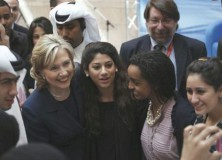U.S. Public Diplomacy in the Middle East after 9/11 — Justin Logan

INTRODUCTION:
In the wake of the attacks on the United States on September 11, 2001, the question “why they hate us” became a topic of interest to U.S. policymakers. Opinion leaders and government officials began referring to a “war of ideas” and the struggle over who would influence “hearts and minds.” At the root of this emphasis was increasing recognition that in the years to come, the opinions and decisions of foreign individuals, in addition to those of other nation-states, could greatly impact the security of American citizens. However, as U.S. officials began mounting a campaign to influence public opinion in the Islamic world, it soon became clear that the strategy being employed was deeply flawed. The position of under secretary for public diplomacy and public affairs—the top public diplomacy posting in the government—has turned over five times from October 2001 to the present and as the Bush administration’s five public diplomacy czars came and went, the White House, the State Department and other executive branch agencies approached public diplomacy in an ad hoc manner. It was June 2007 before the White House released a formal national strategy for public diplomacy. Further, the marginal positive effects of official public diplomacy efforts have proven easily undermined by off-the-cuff statements and unplanned events, from the abuses of Abu Ghraib and Guantanamo Bay, to Lt. Gen. William G. Boykin’s couching the war on terrorism in explicitly religious terms, to the President’s own misstep in calling the war on terrorism a “crusade.”
STRATEGY:
The Bush administration completed its strategy for public diplomacy in June 2007, five and a half years after the 9/11 attacks. Before that time, efforts were largely ad hoc and unsupported by doctrinal guidance and it remains unclear the impact this new strategy will have. The U.S. approach to challenges in the Middle East since 9/11 failed to consider public diplomacy while creating policy, reinforcing the reactive nature of public diplomacy efforts and resulting in ill considered policy choices. In addition, the revolving-door ethos at the position of under secretary for public diplomacy and public affairs prevented a comprehensive strategy from emerging within the State Department.
INTEGRATED ELEMENTS OF NATIONAL POWER:
One finding that is common across nearly all assessments of U.S. public diplomacy efforts in the Middle East was that future progress in efforts to revamp public diplomacy would hinge on strong support from the White House. Without this, there has been a general failure to integrate public diplomacy with a wide range of U.S. government activities throughout the Middle East. This has also resulted in the failure of the U.S. government to project a uniform message when conducting these activities and kept public diplomacy out of sync with policy.
EVALUATION:
In particular, the inaccurate determination of factors affecting the perception of foreign publics, the lack of a clear strategy and metrics for determining outcomes, a failure to unify the public diplomacy effort, a lack of interface between public diplomacy concerns and U.S. foreign policy, high turnover and resource shortfalls in the State Department and lack of emphasis by the White House help to explain the weakness of the U.S. government response.
RESULTS:
U.S. public diplomacy efforts in the Middle East after 9/11 have been unable to prevent a hugely negative trend in public perceptions of the United States. U.S. policy has remained extremely unpopular in the region, and a dangerous pattern has emerged in which antipathy for certain policies veered into an overarching, “essentialist” negative view of America.
CONCLUSION:
It is true that U.S. public diplomacy efforts heretofore have been hobbled by an inaccurate diagnosis of the problem, murky strategic conception, poor implementation, a lack of unity of effort and a failure to create a means of interface between policymaking and public diplomacy. But fixing these process flaws will not ameliorate the underlying reality: By and large, Muslims dislike what we do, not who we are. U.S. foreign policy should not be crafted with public opinion of the Islamic world as the foremost consideration. An outright critique of post-9/11 foreign policy is well beyond the scope of this case study, but what is not beyond its scope is the acknowledgement that the linkage between U.S. policies and public diplomacy efforts is not a burden to be dodged or a spurious connection.